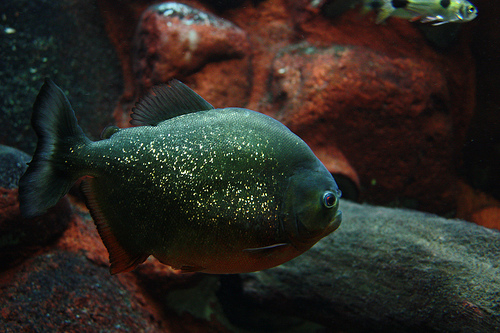Munch, munch goes the ‘ferocious’ piranha.
- Piranhas are a type of fish, that are coloured yellow, grey, red or blue, and are native to South America’s freshwater rivers.
- A ‘piranha’ is also known as a ‘piraña’, and contrary to popular belief, they are not generally fierce and courageous, and as a result they live in schools for protection.
- Piranhas are from the family Characidae, a family of tropical and subtropical freshwater fish, and the subfamily Serrasalmidae, the serrated salmon fish, and there are at least three or four official genus groupings, with an estimated species count of 30 to 60.
- Piranhas generally range in length from 14 to 30 centimetres (5.5 to 11.8 inches), however lengths of up to 80 centimetres (31.5 inches) have been recorded.
- A piranha’s diet predominantly consists of meat, particularly fish, insects and snails, as well as vegetation in the water, and it can also include birds and mammals.
Piranha
Image courtesy of Georgios Michalogiorgakis/Flickr
- Indigenous South Americans sometimes use the sharp teeth of piranhas to create weapons or tools.
- Piranhas can be kept in captivity as a pet, but some governments have determined this illegal, and while they rarely cause human deaths by attacks, they can cause various injuries, particularly on the hands or feet.
- Between 1913 and 1914, the former president of the United States of America, Theodore Roosevelt, saw and documented piranhas, and stated that “They are the most ferocious fish in the world.”
- Female piranhas lay approximately 5000 eggs in a nest, in one season, and the eggs are heavily protected by the parents, causing a survival rate of up to 90 percent.
- Piranhas typically live to be 20 to 25 years old, although they are preyed upon by caimans (small crocodylians), some birds, other fish, turtles and dolphins.
Bibliography:
Piranha, 2013, A-Z Animals, http://a-z-animals.com/animals/piranha/
Piranha, 2014, Wikipedia, http://en.wikipedia.org/wiki/Piranha







